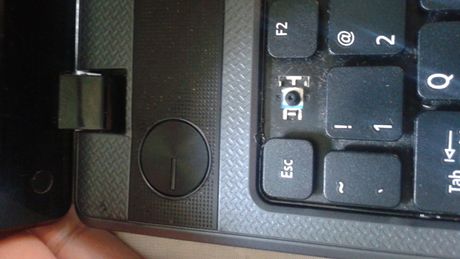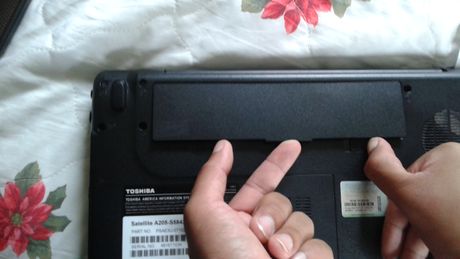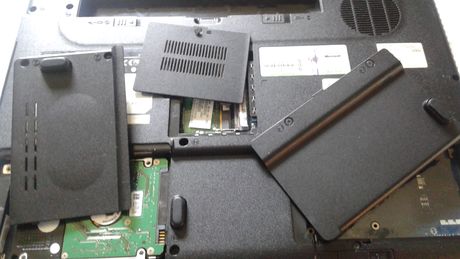How to Replace a DC Jack in a Laptop
Part 1 of 2:
Dis-Assembly
-
 Turn off the laptop.
Turn off the laptop.- You never want to begin repairing a laptop or any electrical system while the power is still on. It could shock you and/or damage the internal components.
- Pull out the battery.
- It is located at the bottom of the laptop. It will have two spring loaded tabs that you pull out while taking the battery out.

- It is located at the bottom of the laptop. It will have two spring loaded tabs that you pull out while taking the battery out.
- Hold down the power button for 40 seconds.
- This will discharge static electricity that can damage your laptop's sensitive components.
-
 Unscrew the hard drive and RAM doors.
Unscrew the hard drive and RAM doors.- Some screws will not come off, they are simply unscrewed, but remain attached to the hole that it is in, when you take the door off.
-

 Pull out RAM cards. Take a picture.
Pull out RAM cards. Take a picture.- The RAM card is a small rectangular circuit board, held in to a silver housing.
- Where you see the screwdrivers touching, you must push those tabs out and the RAM card will pop up.
- When pulling these out you want to push the tabs out on each side and the RAM card will pop up and you can pull it out very easily.
- You should never have to force the RAM cards out.
-
 Pull out the hard drive. Take a picture.
Pull out the hard drive. Take a picture.- Easily pulled out from its connection.
- Pull out the keyboard screw cover. Use the computer chip lifter.
- You can pop the edges out, when running the computer chip lifter by the joints.

- You can pop the edges out, when running the computer chip lifter by the joints.
-
 Pull off the keyboard slowly. Take a picture
Pull off the keyboard slowly. Take a picture- Unscrew the screws that are holding it to the laptop.
- The is a strip connector in the motherboard that can break if yanked.
- There will be a plastic lock that has two locking tabs you must pull those out in order for it to let the strip loose.


- Unscrew screws from under the keyboard.
- screws are not connected to the keyboard itself, but to the face-plate directly under where the keyboard was.

- screws are not connected to the keyboard itself, but to the face-plate directly under where the keyboard was.
- Unscrew the screws from under the laptop and unscrew the small screws from the battery opening.
-
 Pull out the DVD drive.
Pull out the DVD drive.- Unscrew its screw.
- Put a paper clip in its manual open hole and the DVD drive will be able to be pulled out.
-
 Pull off top plate slowly. Take a picture.
Pull off top plate slowly. Take a picture.- Cords from the power button and the touch pad will be attached to the motherboard. These need to be pulled off before you can pull it off entirely.
- Once those have been disconnected pull off the top plat by its edges.
- Once that is off the motherboard will be exposed.
-
 Unscrew the screws attaching the motherboard to the chassis. Take a picture.
Unscrew the screws attaching the motherboard to the chassis. Take a picture. - Pull the fans power cord from the motherboard. Take a picture
-
 Unscrew the fan from the motherboard.
Unscrew the fan from the motherboard. -
 Pull of any cords connecting to the motherboard and flip it over. Take a picture, possibly more than one in order to get all of the details.
Pull of any cords connecting to the motherboard and flip it over. Take a picture, possibly more than one in order to get all of the details.- The DC jack will look like this.
-
 Pull out the old DC jack from the motherboard and from the chassis (input and output). Take a picture.
Pull out the old DC jack from the motherboard and from the chassis (input and output). Take a picture. - Insert the new DC jack to the motherboard and chassis.
Part 2 of 2:
Re-Assembly
- Place motherboard in place in the chassis that it was taken from before flipping it over.
- The motherboard will have to be played with a little in order to get it in. It will go in in the exact same way it was taken out.
- Sometimes, depending on the laptop that you have, the headphone and mic jacks, the ethernet cord port will have an opening in the chassis that you can fit in.
- During this process, try not to flex the motherboard too much.
- Reconnect all cords to the motherboard.
- This usually includes: touch pad, keyboard, power button, USB cords, Wired internet cords, wifi adapter. Anything that you unplugged while taking the motherboard out.
- Reference the pictures you took during dis-assembly
- Screw in the fan and plug in its cord.
- The fan will go in same way it came out.
- Re-attach the face plate.
- Be sure to plug in its cords while connecting it.
- The joints will be connecting to each other and slicking when they have been connected. That is how you know the chassis and face-plate are connected.
- Plug in the keyboard.
- Be sure to plug in its strip to the motherboard before laying it flat and screwing it in.
- This goes in, in the opposite of its removal. You will have to connect the strip to the locking tab.
- After you connect the strip connector to the locking tabs. Give it a very light tug to make sure it is locked in.
- Screw in screws to the back of the laptop.
- Insert DVD drive.
- It will slide right in to the slot.
- There is a screw that holds the DVD drive to the bottom of the laptop, it will be a small screw. Screw that in now.
- Insert RAM cards.
- Slide Ram into its port the opposite way that it was removed and when you hear a click, its in.
- Insert the hard drive.
- The hard drive will slide in very easily just as it was pulled out.
- Cover the RAM cards and hard drive with their respective doors and screw those in.
- Troubleshoot as needed:
- If you can't remove the DC jack it may not be a plug in type some must be de-soldered. Before beginning the repair search the type of DC jack within your specific laptop.
- If some screws don't go back in, you may have gotten confused with the screws. Different parts of the laptop carry different sized screws.
- Most times the laptop doesn't need half the screws in it, the screws make it stronger against drops. You can purchase the screws in most electronic and/or computer repair stores.
- If after the repair is complete and the laptop still does not charge or turn on, you may have had another problem. Take a look at the Related Article about diagnosing this problem. The problem could have a simple fix.
- If the keyboard is not working, you will have to remove the keyboard and make sure that the strip connector is locked in.
- If the DVD drive doesn't slide into its slot smoothly, don't try to jam it in that could damage a cord. Use the computer chip lifter to move the cords out of the way of the DVD drive.
3.5 ★ | 2 Vote
You should read it
- Things to know when choosing to buy mainboard
- Leaked images of upcoming Lenovo gaming motherboards
- What is motherboard? Learn about the mainboard in the computer
- 5 best B760 motherboards in 2024
- How to find motherboard compatible RAM
- List of MSI motherboards that support TPM 2.0
- Thresh champions should pull in the DTCL
- List of Asus motherboards that support Windows 11
May be interested
- All things about Jack Ma - Billionaire admires the whole world
 alibaba owner jack ma - ma van, has failed many times before setting up alibaba, likes long tinh tea and singing in company events ... jack is currently the second richest asian as well as china owns assets worth 41.8 billion usd (as of early 2017).
alibaba owner jack ma - ma van, has failed many times before setting up alibaba, likes long tinh tea and singing in company events ... jack is currently the second richest asian as well as china owns assets worth 41.8 billion usd (as of early 2017). - How to Add Oil to a Hydraulic Jack
 a hydraulic jack is a device used to lift heavy objects, usually cars or trucks. the system works by using oil to grease the internal mechanism. if you've just bought a new jack, it won't have any oil in it and you'll have to fill it....
a hydraulic jack is a device used to lift heavy objects, usually cars or trucks. the system works by using oil to grease the internal mechanism. if you've just bought a new jack, it won't have any oil in it and you'll have to fill it.... - 2 basic steps to replace, upgrade laptop RAM
 your laptop is slow, or hangs. the cause may be due to ram. just fix the error, replacing the new ram will work faster. the following article shows you how to manually change the ram acer asprise 5100 laptop, similarly to other laptops.
your laptop is slow, or hangs. the cause may be due to ram. just fix the error, replacing the new ram will work faster. the following article shows you how to manually change the ram acer asprise 5100 laptop, similarly to other laptops. - How to fix laptop headphone jack error still playing external speakers
 one of the common mistakes we see on laptops is plugging in headphones, but the computer still plays external speakers. in this article, the software tips will guide you on how to fix laptop headphone jack error still playing external speakers.
one of the common mistakes we see on laptops is plugging in headphones, but the computer still plays external speakers. in this article, the software tips will guide you on how to fix laptop headphone jack error still playing external speakers. - What is a headphone jack? Compare 3.5mm and 2.5mm jacks in detail
 the headphone jack is an extremely popular device today. so what is it about the headphone jack that so many people love? let's find out in the following article.
the headphone jack is an extremely popular device today. so what is it about the headphone jack that so many people love? let's find out in the following article. - Instructions for removing laptop Acer Aspire ES1-532G
 if you are using an acer aspire es1-532g computer and want to remove the laptop to replace the hard drive, clean the fan, replace the ram, replace the battery, even replace the motherboard, wifi card, remove the laptop acer aspire es1-532g please follow this video tutorial.
if you are using an acer aspire es1-532g computer and want to remove the laptop to replace the hard drive, clean the fan, replace the ram, replace the battery, even replace the motherboard, wifi card, remove the laptop acer aspire es1-532g please follow this video tutorial. - Watch live billionaire Jack Ma talking at the National Convention Center right now
 billionaire jack ma is presenting at the national convention center and will have a talk with vietnamese students. please watch the live video here.
billionaire jack ma is presenting at the national convention center and will have a talk with vietnamese students. please watch the live video here. - Instructions for replacing a broken laptop screen
 if you accidentally damage your laptop screen or there are many dead spots appearing, don't worry. you can completely replace the screen for your laptop, just follow the instructions below.
if you accidentally damage your laptop screen or there are many dead spots appearing, don't worry. you can completely replace the screen for your laptop, just follow the instructions below. - 9 things Jack Ma sent to his son made us ponder
 jack ma is admired by many people and is known for his different perspectives on work as well as in teaching children.
jack ma is admired by many people and is known for his different perspectives on work as well as in teaching children. - Hey phone manufacturer, give us back the headphone jack!
 it has been a year since apple officially removed the 3.5mm headphone jack from iphone 7 and called it 'a brave'.
it has been a year since apple officially removed the 3.5mm headphone jack from iphone 7 and called it 'a brave'.



























 How to Crimp a Wire
How to Crimp a Wire How to Protect an Outdoor Ethernet Cable
How to Protect an Outdoor Ethernet Cable How to Identify Aluminum Wiring
How to Identify Aluminum Wiring How to Forward Your Home Phone to a Cell Phone
How to Forward Your Home Phone to a Cell Phone How to Extend USB Cable
How to Extend USB Cable How to Connect to Ethernet on PC or Mac
How to Connect to Ethernet on PC or Mac